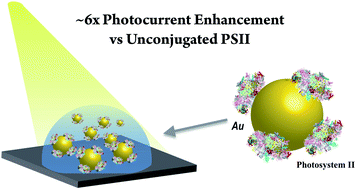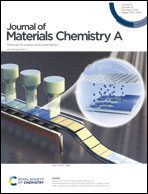Functionalized gold-nanoparticles enhance photosystem II driven photocurrent in a hybrid nano-bio-photoelectrochemical cell†
Abstract
The use of photosystem II (PSII) in hybrid bio-photoelectrochemical cells for conversion of solar energy to electrical current is hampered by PSII's narrow absorption cross-section and the generally poor electrical connection between isolated complex and different anode materials. Here, we merge isolated market-grade spinach PSII with 25 nm cystamine-2,6-dichlorobenzoquinone (cys-DCBQ) modified Au-nanoparticles (PSII–AuNPCys-DCBQ) to obtain one of the highest reported photocurrent values to date (35 mA cm−2 mg−1 chlorophyll), retaining the native oxygen evolution properties of PSII. More than 80% of the PSII in solution assembles stably onto the AuNPCys-DCBQ. Spectroscopic studies show strong functional association in these hybrid particles. Mechanistic investigations reveal a dual role of the quinone-modified AuNPs, harvesting and transference of the excitation energy to PSII (resulting in ∼10-fold enhancement of anodic photocurrent in the 500–550 nm irradiation range) and simultaneously improving the electron transfer from PSII into the graphite anode (by almost 6-fold over the entire visible range of light).



 Please wait while we load your content...
Please wait while we load your content...